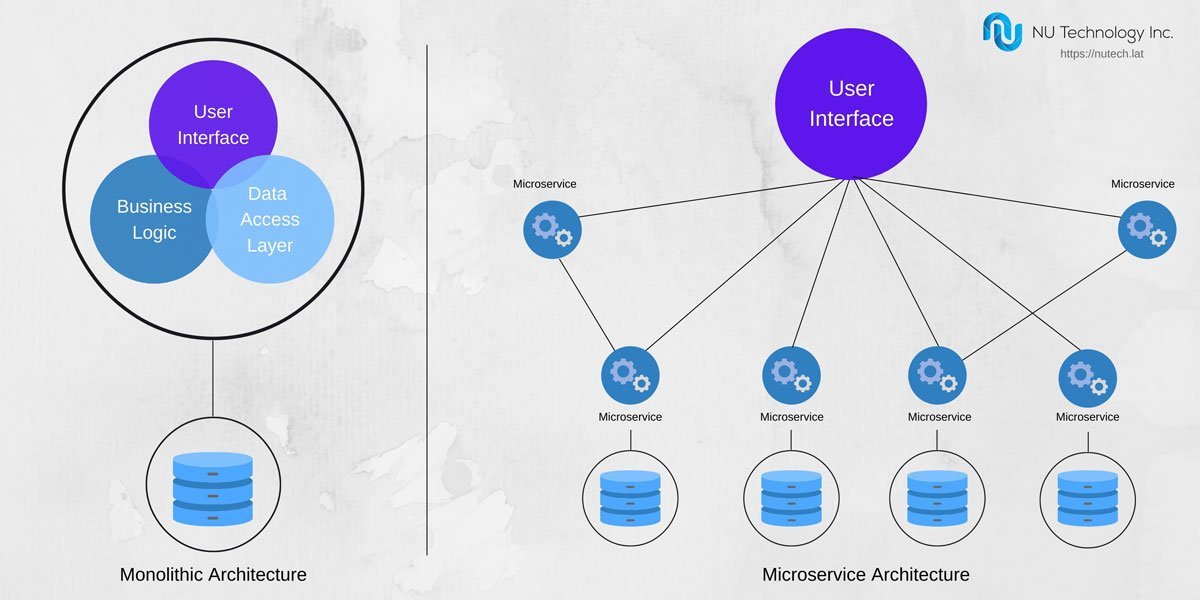With a fast-changing world, where technology is overtaking almost everything, it is no surprise that businesses that were once ‘offline’ are now becoming ‘online.’ Nowadays, lacking an excellent internet profile means your business doesn’t exist. As a result, organizations and companies are giving huge attention to computer software designs, user interfaces, and much more.
The two main categories of software architecture are 1) Monolithic and 2) Microservices. You might have heard about ‘microservices’ being superior to ‘monolithic’ however, is that really the case? Let’s find out!
What Is Monolithic Architecture?
Before answering the question, let us figure out what the word ‘monolith’ actually means. It is defined as something large that gets even larger with time. In software terms, a monolithic architecture means everything, starting from handling HTTP requests to executing logic and interacting with databases, all server-sided applications are performed at one single platform. At first, monoliths are straightforward to use however, with time, their size increases, and so does their complexity.
What Are Microservices?
Groups of small, modular units grouped according to their codes are microservices. Since these aren’t interconnected as much as monoliths, these can be deployed or run independently. If one unit needs modification, others remain undisturbed. Also, each unit focuses only on one topic at a time.
Now that you know the differences between the two, let’s figure out why people prefer microservices over monoliths.
Why Microservices And Not Monolithic Architecture?
Following are some of the guaranteed advantages of using microservices:
1. Easy to update software features.
2. Easy to extend your platform.
3. Easy to omit or add new features.
4. Easy to maintain and test application functions.
5. Flexible usage of code language and other tools.
All the tasks mentioned above can be done within a monolithic architecture as well. However, since everything there is interdependent, a slight change in one module will require changes in every other module. That would result in more time and money being needed and so would decrease your company’s service profile.
In short, microservices keeps everything organized and independent for faster and cheaper updates or amendments needed in the codebase. You can also deploy modules one by one instead of waiting for all of them to be developed!
Which Architecture Best Fits Your Company?
As you have seen, both monolithic and microservice architecture have their benefits and drawbacks. It is also essential to understand that various stages in business development require various architecture forms, so you might end up using both!
Where To Use Monolithic Architecture?
• Startup businesses with small projects and simple models.
• Short duration projects.
• Softwares that do not need frequent updates or amendments.
Where To Use Microservices?
• Softwares that require agility and a smooth approach towards complex projects with the help of experienced and expert developers.
• Softwares that are starting small but plan to expand and acquire more functions and functionality with time.
• Softwares that are meant for a long-run project.
To clear things out, most organizations start with monoliths for their simplicity and ease of use; however, with time, monoliths no longer remain such; they grow harshly complicated and messy! Organizations then tend to shift to microservices to put everything back in place where it can be controlled. Using microservices from the beginning isn’t a great choice either since the initial setup might take more time than you think.
How To Shift To Microservices From Monolith?
Now that you are aware of the challenges you might face to continue a monolithic architecture and how microservices are a better option, let us see how to do so. Below are listed some of the best practices to follow to ensure a successful transfer from monolith to microservices:
Organizational Changes
When you are changing the software design, you are modifying both the software’s architecture and the work pattern of your business. Listed are some things you should do:
- Construct goals and objectives: When commencing with anything new, it is a must to establish specific, explicit, and understandable goals. Before creating such, make sure to consider how the changes will affect your current workforce and if you should create new workflows to even things out. Planning needs to be done in agreement with every member. Having a support system along with being equipped with valuable resources will make this change easier for everyone.
- Monitor and measure KPI: Using Key Performance Indicators (KPIs) to manage microservices will ensure a successful transfer among the architecture types. Calculate how to increase deployment frequency and note down which changes result in faster deployment. Get help from various metrics or establish your own to monitor your KPIs.
- Begin with few modules: Microservices include a wide range of codebases and modules. Trying to achieve and perfect all at once would be overwhelming and uncontrollable. As a consequence, your deployment will get delayed. Therefore, to have a lucrative journey, start small and focus only on the critical factors at first.
- Establish cross-functional teams: This team must be able to develop, design, and build operations without the need for assistance or help from other firms. That being said, this team is expected to have talented developers, obedient operators, and professional business owners. The team will act as a center point between the different modules of microservices.
- Forget the monolith structure: If you base your micro-service modules on the monolithic properties, you aren’t improving anything. Code bases should be kept separate. It is also important to note that the monolith will entertain customers until and unless the microservices are fully implemented and tested. The ‘strangler-fig’ method, which means the microservices will slowly overtake the monolith, can be used as well.
Application Changes
When you are starting with the new architecture, consider the following:
- Installing Anti-Corruption Layer: This ensures your monolith and microservices are kept separate even when transmission and interaction of data are involved. The layer mainly translates Monolith Application Programming Interface (API) to Microservices API.
- Streamline your build: Your build process needs all magic variables and special environment variables to be removed. This is done to understand your system efficiently. After this, cut off dependencies among your monolithic modules to strategize a better approach.
- Use an app development software and monitoring tools: To look through databases and message queues, applications that help developers enact their ideas can be used. One popular software, Docker, can be a great choice. Monitoring tools should be devised to maintain similar metrics for a fair comparison of performance.
- Implement: To know how your microservices would react to different forms of data, contact Internet hosting providers such as GitHub.
- Observe: Check for error rates and find out the environments causing them. You can then remove these and request payloads, deployment versions, and local variables.
There are numerous ways to get microservices running at your organization. With new ideas comes great challenges, so failure should be thought of as a way to get better. Nonetheless, with the correct determination and planning, your route of shifting from a monolithic architecture to microservices is guaranteed to be successful.
We will be happy to advise on the best architecture for your enterprise systems and applications including the migration from monolithic systems to microservices. Contact one of our experts for a free asessment.



